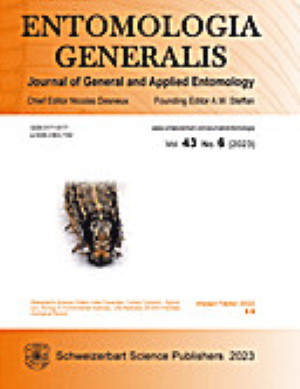转铁蛋白影响长角血蜱的食物摄取和繁殖
IF 4.6
1区 农林科学
Q1 ENTOMOLOGY
引用次数: 0
摘要
转铁蛋白(Tsf)是一种在脊椎动物中对铁具有高亲和力的细胞外蛋白,但其在蜱中的功能和机制尚不清楚。本研究首次对硬蜱长角血蜱(伊蚊目:伊蚊科)中的Tsf进行了研究。结果表明,Tsf在幼虫、若虫和雌虫的3个发育阶段和不同组织(唾液腺、卵巢、中肠和马尔比氏小管)中均有表达,血餐后表达量较高。利用大肠杆菌表达系统,发现硬蜱Tsf蛋白在体外具有铁螯合、自由基清除、抗菌和溶血活性。RNA干扰(RNA interference, RNAi)对长角天竺蜂的取食能力和繁殖能力产生不利影响,导致长角天竺蜂的膨体重、卵巢重、卵质量重、卵孵化率下降,卵从产卵到幼虫孵化期延长。此外,我们还利用蛋白质组学研究了Tsf对长角家蝇雌性摄食和繁殖的影响机制。结果表明,Tsf可能通过多种途径影响这些过程,包括泛素-蛋白酶体途径、脂质代谢途径、碳水化合物代谢途径、氧化应激、异常mRNA降解、内吞作用、囊泡运输和细胞周期调节。这些结果有助于更好地理解Tsf在蜱中的作用和机制。此外,本研究还从抑制蜱铁代谢的角度为抗蜱疫苗提供了一种新的抗原。本文章由计算机程序翻译,如有差异,请以英文原文为准。
Transferrin affects food intake and reproduction in the hard tick Haemaphysalis longicornis
Transferrin (Tsf) is an extracellular protein with a high affinity for iron in vertebrates, but its function and mechanism in ticks are poorly understood. This study investigated Tsf in the hard tick Haemaphysalis longicornis Neumann (Ixodida: Ixodidae) for the first time. The results showed that Tsf was expressed in three developmental stages (larva, nymph, and female) and in various tissues (salivary glands, ovary, midgut, and Malpighian tubules), with higher expression levels observed after a blood meal. Using the Escherichia coli expression system, it was revealed that the hard tick Tsf protein exhibited iron chelation, radical-scavenging, antibacterial, and hemolytic activities in vitro. Silencing Tsf using RNA interference (RNAi) had adverse effects on the feeding ability and reproduction of H. longicornis, resulting in decreased engorgement weight, ovary weight, egg mass weight, egg hatching rate as well as a prolonged incubation period of eggs from oviposition to larvae hatching. Additionally, proteomics was used to investigate the mechanisms underlying the effects of Tsf on food intake and reproduction in H. longicornis females. The results revealed that Tsf may affect these processes through various pathways, including the ubiquitin–proteasome pathway, lipid metabolic pathways, carbohydrate metabolic pathways, oxidative stress, abnormal mRNA degradation, endocytosis, vesicle transport, and cell cycle regulation. These results contribute to a better understanding of the function and mechanism of Tsf in ticks. Furthermore, this study provides a novel antigen for anti-tick vaccine from the perspective of inhibiting tick iron metabolism.
求助全文
通过发布文献求助,成功后即可免费获取论文全文。
去求助
来源期刊

Entomologia Generalis
生物-昆虫学
CiteScore
7.10
自引率
18.80%
发文量
72
审稿时长
>12 weeks
期刊介绍:
Its scope covers all aspects of basic and applied research dealing with insects and more broadly with arthropods inhabiting wild, agricultural and/or urban habitats. The journal also considers research integrating various disciplines and issues within the broad field of entomology and ecology.
Entomologia Generalis publishes high quality research articles on advances in knowledge on the ecology and biology of arthropods, as well as on their importance for key ecosystems services, e.g. as biological control and pollination. The journal devotes special attention to contributions providing significant advances (i) on the fundamental knowledge and on sustainable control strategies of arthropod pests (including of stored products) and vectors of diseases, (ii) on the biology and ecology of beneficial arthropods, (iii) on the spread and impact of invasive pests, and (iv) on potential side effects of pest management methods.
Entomologia Generalis welcomes review articles on significant developments in the field of entomology. These are usually invited by the editorial board, but proposals may be sent to the Editor-in-Chief for preliminary assessment by the editorial board before formal submission to the journal. The journal also considers comments on papers published in Entomologia Generalis, as well as short notes on topics that are of broader interest.
 求助内容:
求助内容: 应助结果提醒方式:
应助结果提醒方式:


